ch 11
P_M_A Lab_11_1
Basic Static Analysis
opening with PEStudio found hashes, searching for it using virus total found it’s detected as dropper

looking at strings found lots of suspicious ones

from DIE it’s not packed
So it will drop another malware from basic static and will achieve Persistence through registry
Basic Dynamic analysis
from process tree the malware opens cmd, from procmon it creates a file in C:\Windows\System32 which is very suspicious it also modify and creates registers that maybe used to achive Persistence, it also created a file in the same destination under name “msgina32.dll” now its enough let’s restor our snapshot then start the advanced analysis
Advansed analysis
I prefer to start both static and dynamic together on ida_pro the frist thing opens is :

from queck look at this it creates the file mentioned before there is also two calls so lets set our break points there and start the analysis
frist it gets the handel to module then in the function sub_401080 there is a call to FindResourceA which Determines the location of a resource with the specified type and name in the specified module named “TGAD” and has type of “BINARY” if succeded the next call is LoadResource which retrieves a handle that can be used to obtain a pointer to the first byte of the specified resource in memory. if succeded we have a handle to the data associated with the resource. then the nex call is LockResource which retrieves a pointer to the specified resource in memory, then we have a pointer to the first byte of the resource then SizeofResource that get the size in bytes (6656)or(0x00001A00) byte now VirtualAlloc, let’s take a deep look at it’s parameters

1- protiction : here the value is 4 which means PAGE_READWRITE 2- allocationtype : 1000h stands for MEM_COMMIT 3-dwsize : 0x00001A00 4-lpadress : 0 The starting address of the region to allocate
so we have now allocated the memory in this adress
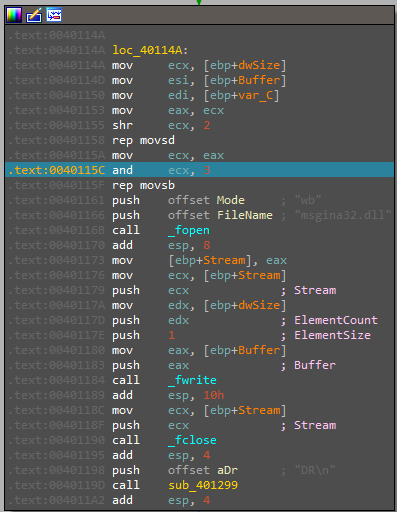
then the data at the resourse are copied to ecx then then anding with 3 and move again to eax then open file called “msigna32.dll” with “wb” mode for write in binary then write date using _fwrite and finally close the file
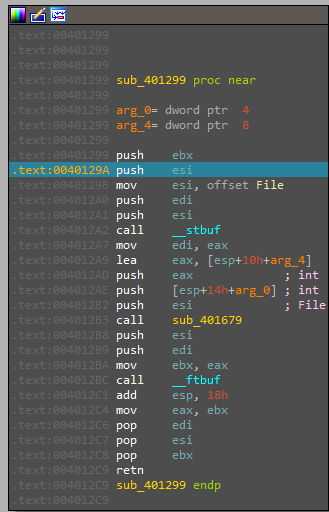
here another call which contain setting buffer
so from here there is no need to continue, It’s better to goto the next function call as it’s obevious that this function (sub_401080) is the one used to drop the malware
let’s get back to the main

here this get handle to the created file then pass it to our target sub_401000

here that creates a regkey hKey\SOFTWARE\Microsoft\Windows NT\CurrentVersion\Winlogon thing to notice is the dwoptions set to zero stands for “REG_OPTION_NON_VOLATILE” another thing is “samDesired” set to 0F003Fh which means that the key has KEY_ALL_ACCESS access rights
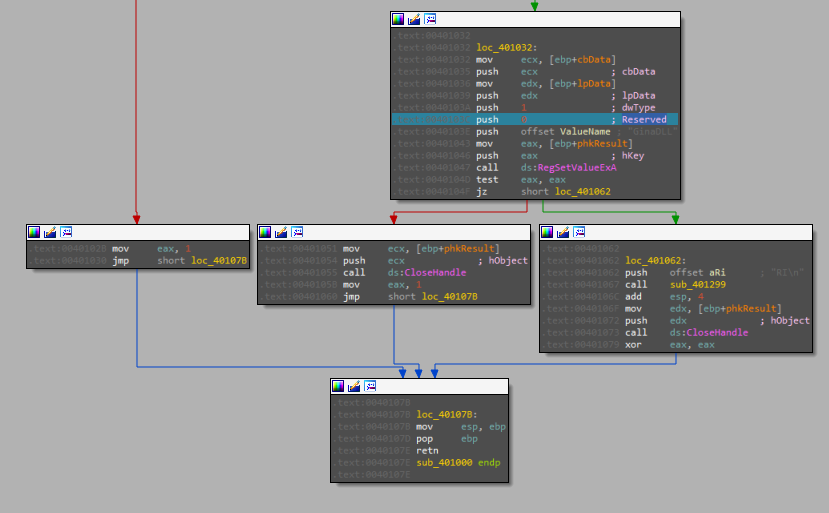
here the malware is setting value “GinaDLL” to the created key then close a handle and close the file
from this we now that
- The malware is dropped as msgina32.dll from resourse TGAD
- The malware is being installed as GINA DLL
- the DLL to be loaded after system reboot by adding it to HKLM\SOFTWARE\Microsoft\Windows NT\CurrentVersion\Winlogon
GinaDLL.
That maybe a known Credential Stealer method called GINA Interception
let’s start with the dropped file “msgina32.dll”
Basic Analysis2
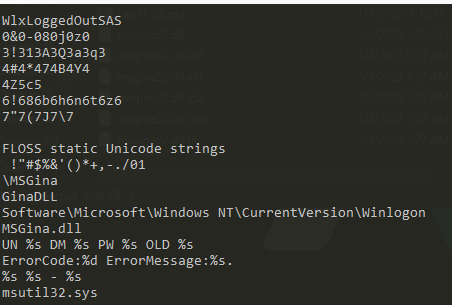
this contains the message to be displayed which could be used to log user credentials
Advanced analysis
the first thing to do with dll file is chicking exports
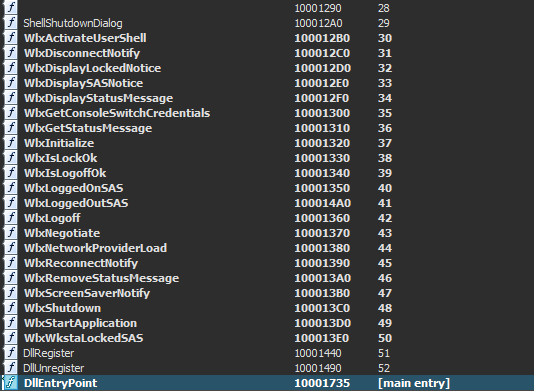
there are many functoin starts with wlx which is required by normal gina
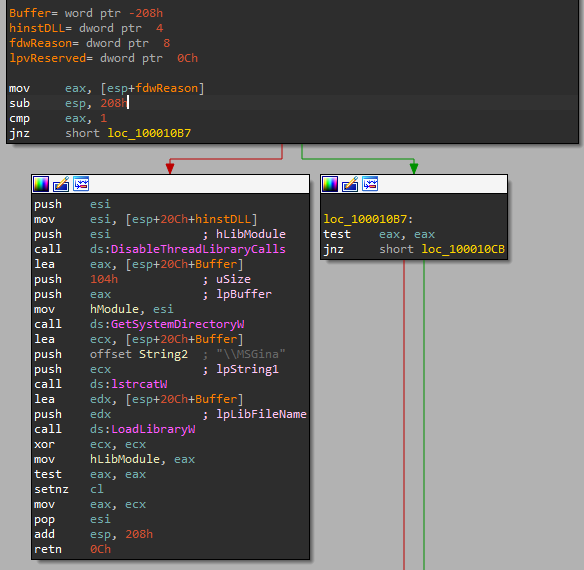
first the dll compare eax with one to find out the reson for dll being loaded
then the left bransh we need to examine has DisableThreadLibraryCalls which used to disables the DLL_THREAD_ATTACH and DLL_THREAD_DETACH notifications
then GetSystemDirectoryW wihch retrieves the path of the system directory, from here it gets an easy handle to msgina.dll then call it with loadlibraryW then the handle is moved from eax to hLibModule which allows the dll to call msgina.dll functions
here the main ends it’s time to examine exports called from the original dll
as we suspect GINA Interception then I started with “WlxLoggedOutSAS”

it simply uses the handle (hLibModule) created before to get the address through the malicious subroutine sub_10001000 then return the address to eax and jumb there which prevent the function from creating stack fram and pushing return value as it hasn’t been actually called
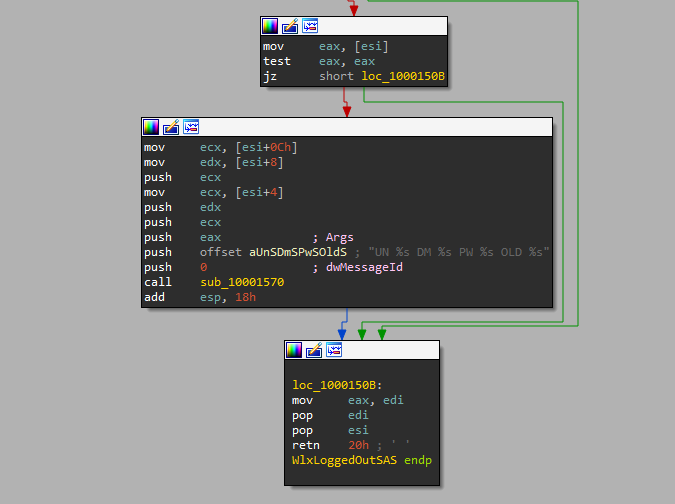
here there is a message to be passed to sub_10001570
![sub]/assets/images/Tutorials/sol-practical%20malware%20analysis/ch_11/lab11_1/(pics/10001570_1.png)
first _vsnwprintf is called to write formatted output using a pointer to a list of arguments that come from WlxLoggedOutSAS then _wfopen opens msutil32.sys
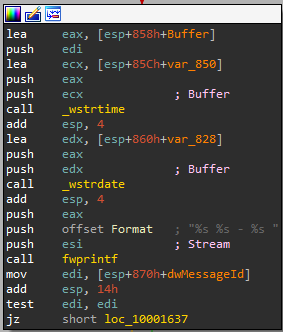
then [_wstrtime,_wstrdate] both record date and time then fwprintf write loged data to the opend file so this file is used to store stolen date after logging out
Tools used :
- IDAFREE-7.7
- PEStudio
- DIE
- Procmon